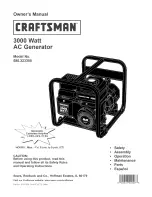
PCB 299B is similar to the standard sample daughterboard, except that it provides a
footprint for an Analog Devices ADUM241E0BRWZ in a wide SO-16 SMT package. The
DUT must be soldered to the daughterboard. (A DUT socket is not practical for these
tests, since the extra parasitic capacitance introduced by a socket would severely
degrade the measured CMTI.)
Installation is similar to the standard daughterboards. For positive pulse mode, the
“AMP1” front-panel setting must be set to a positive value
AND
the daughterboard must
be installed in the socket so that it is in the left-most position (when viewed from the
DUT area door opening), closest to the socket lever.
For negative pulse mode, the “AMP1” front-panel setting must be set to a negative
value
AND
the daughterboard must be installed in the socket so that it is in the right-
most position (when viewed from the DUT area door opening), farthest from the socket
lever.
No configuration resistors are installed on this daughterboard by default, to provide
maximum flexibility for the user. Some resistors must be installed before they can be
used for test purposes.
To obtain the sample waveforms below, an Analog Devices ADUM241E0BRWZ was
tested using VCC2 = +5V, and the following daughterboard configuration (including a
rise time degradation capacitance):
Reference
Value
Typical Function
R1
0 Ω for +5V input tests,
not used for 0V input tests.
Zero-Ohm Jumper to connect VIA/VIB/VIC to VCC1
R2
Not used
Zero-Ohm Jumper for VOA as logic output
R3
Not used
Connects VOD to VIA/VIB/VIC, for bidirectional testing
R4
Not used
Zero-Ohm Jumper for VOB as logic output
R5
Not used
Zero-Ohm Jumper for VCC2 to VID
R6
0 Ω
Zero-Ohm Jumper for VOC as logic output
R7
0 Ω
Zero-Ohm Jumper for GND2 to VID
R8
0 Ω for 0V input tests,
not used for +5V input tests.
Zero-Ohm Jumper to connect VIA/VIB/VIC to GND1
P1, P2
150 pF
Rise-time capacitance added between the CAP pads
BT1
One A23-type 12V battery
One user-installed A23-type 12V battery, prime power for VCC1.
(Please note that A23 batteries have a limited mA·hr rating – typically
30 mA·hr when operating at 15 mA – so the battery should be removed
immediately after testing, and its output should verified to be between
6V and 12V before each test.)
With the daughterboard installed in the ZIF socket in the positive position (silkscreen
arrows pointing same direction, daughterboard is as close as possible to the ZIF lever),
and AMP1 set to +1.5 kV and AMP2 set to +5V, these waveforms were obtained:
58
Summary of Contents for AVRQ-5-B
Page 52: ...Bottom side 52 ...
Page 57: ...PCB 299B FOR ADUM241E0BRWZ 57 ...
Page 82: ...PCB 158R2 LOW VOLTAGE POWER SUPPLY ...
Page 87: ...DUT WIRING ON STANDARD DAUGHTERBOARD PCB 267C ...
Page 88: ...DUT WIRING ON CUSTOMIZED TLP2366 DAUGHTERBOARD PCB 298B ...
Page 89: ...DUT WIRING ON CUSTOMIZED ADUM241E0BRWZ DAUGHTERBOARD PCB 299B ...
Page 91: ...PERFORMANCE CHECK SHEET 91 ...
















































